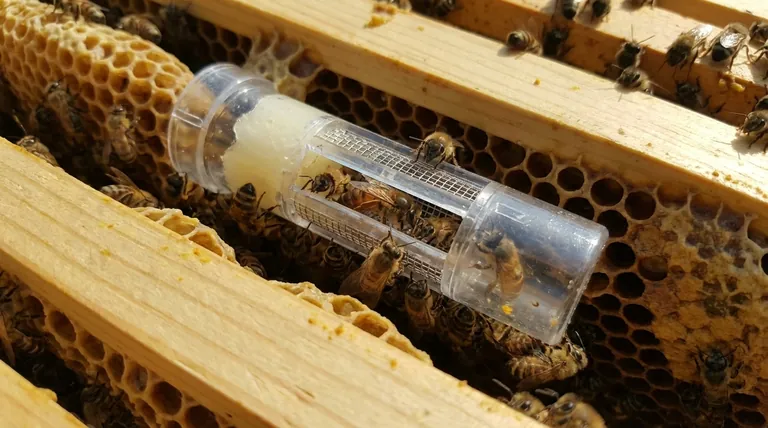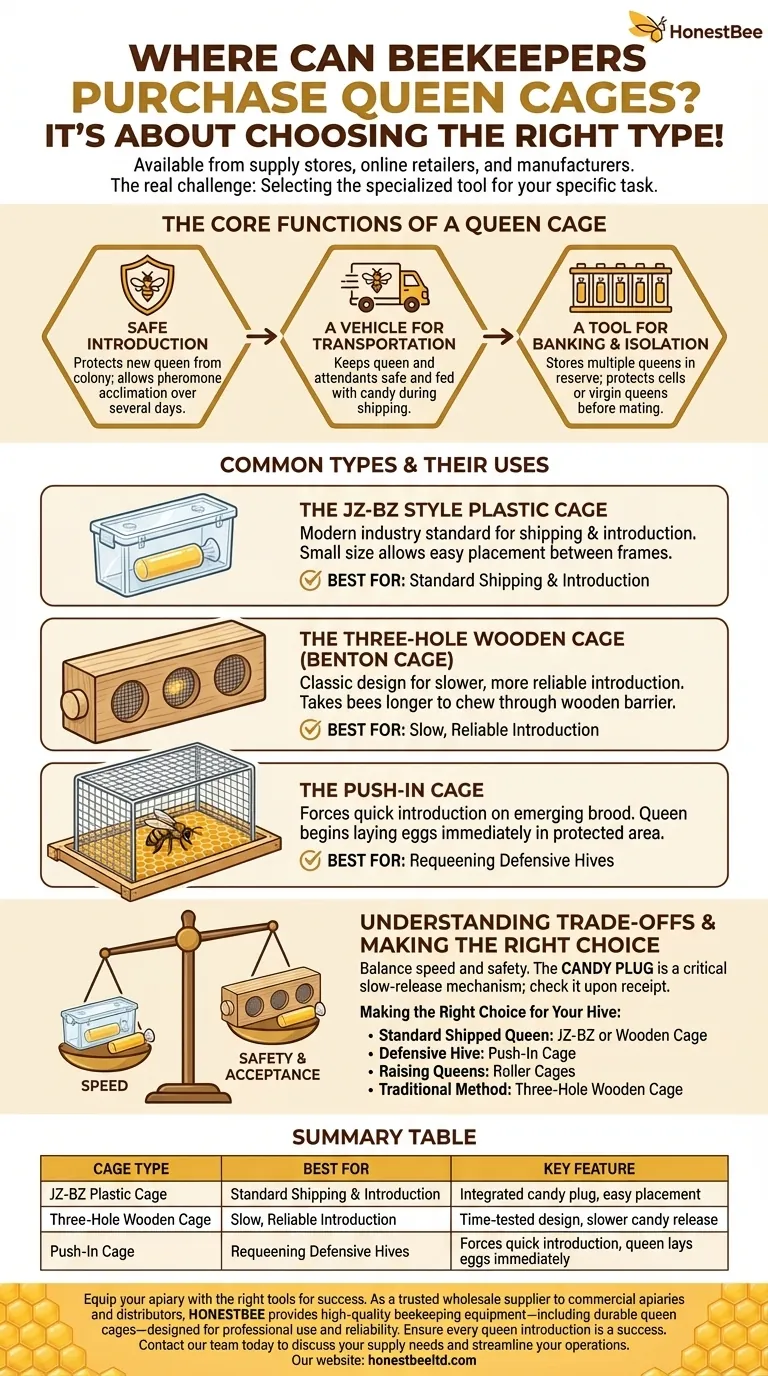In short, you can purchase queen cages from any major beekeeping supply store, large online beekeeping retailers, and in some cases, directly from equipment manufacturers. While they are readily available, the critical decision is not where to buy one, but which type to buy for your specific purpose.
The real challenge for a beekeeper isn't finding a vendor for queen cages. It's understanding that different cages are specialized tools designed for different tasks, primarily queen introduction, transportation, and isolation.

The Core Functions of a Queen Cage
A queen cage is more than a simple container. It is a crucial tool for managing the most important bee in the colony. Its design directly impacts the success of your beekeeping efforts.
The Primary Goal: Safe Introduction
The most common use of a queen cage is to introduce a new queen to a queenless hive. The cage protects the new queen from the colony's workers, who would otherwise see her as a foreign invader and kill her.
Over several days, the new queen's pheromones spread through the cage's mesh, allowing the hive to acclimate to her scent. The workers slowly accept her as their new matriarch.
A Vehicle for Transportation
When you order a queen, she arrives in a cage with several attendant bees. The cage is designed to keep her safe and fed during shipping. The attendants care for her, and a built-in candy plug provides nourishment.
A Tool for Banking and Isolation
Advanced beekeepers use cages to "bank" multiple queens within a single queenless colony, holding them in reserve. Specialized cages like roller cages are also used to protect developing queen cells or isolate virgin queens before mating.
Common Types of Queen Cages and Their Uses
The style of cage you choose depends entirely on your objective. Each has a distinct purpose and method of use.
The JZ-BZ Style Plastic Cage
This is the modern industry standard, often used for shipping queens from suppliers. It is a small, one-piece plastic cage with an integrated tube for queen candy.
These are excellent for both shipping and introduction. Their small size allows them to be placed easily between frames in the brood nest.
The Three-Hole Wooden Cage (Benton Cage)
This is the classic design, made of a small block of wood with three holes drilled into it. Two chambers house the queen and her attendants, while the third is packed with candy.
Many beekeepers feel this cage provides a slightly slower and more reliable introduction, as it takes the bees longer to chew through the wooden barrier around the candy plug.
The Push-In Cage
A push-in cage is a larger, open-bottomed box made of wire mesh. It is not used for transport. Instead, you place the queen on a frame of emerging brood and press the cage into the honeycomb around her.
This method forces a quick introduction. The queen begins laying eggs immediately in the protected area, and the newly hatched bees accept her instantly, helping to spread her pheromones and accelerate her acceptance by the rest of the colony.
Understanding the Trade-offs
Choosing a cage involves balancing speed, safety, and your specific beekeeping goal. There is no single "best" cage for all situations.
Introduction Speed vs. Acceptance Rate
Fast introductions are convenient, but slow introductions are often safer. Plastic cages and small candy plugs can lead to a "fast release," which sometimes results in the queen being rejected.
Wooden cages or adding extra candy can slow the process, increasing the odds of successful acceptance, especially in a colony that is known to be aggressive or has been queenless for a long time.
The Critical Role of the Candy Plug
The candy plug is the slow-release mechanism. If the bees chew through it too quickly, the queen emerges before the hive is ready. If the candy is too hard and they chew too slowly, she could perish in the cage.
Always check the candy plug when you receive a queen. If it's nearly gone, you may need to delay releasing her by adding a marshmallow or more candy to the exit hole.
Material and Reusability
Plastic cages are cheap and effective but can be difficult to clean thoroughly, posing a small risk of disease transfer between hives. Wooden cages can be reused but are more expensive upfront. Push-in cages are durable and used repeatedly for years.
Making the Right Choice for Your Hive
Your decision should be guided by your immediate goal for the colony.
- If you are introducing a standard, shipped queen: Use the JZ-BZ or wooden cage she arrived in, as it is perfectly suited for the task.
- If you are requeening a defensive or difficult hive: A push-in cage gives the queen the best possible start by allowing her to lay eggs in a protected space.
- If you are raising your own queens: Small roller cages are essential for protecting individual queen cells and isolating virgin queens.
- If you prefer a traditional, slow-release method: The three-hole wooden cage is a time-tested and reliable option.
Ultimately, selecting the correct queen cage is a foundational step toward a successful introduction and a healthy, productive colony.
Summary Table:
| Cage Type | Best For | Key Feature |
|---|---|---|
| JZ-BZ Plastic Cage | Standard Shipping & Introduction | Integrated candy plug, easy placement |
| Three-Hole Wooden (Benton) Cage | Slow, Reliable Introduction | Time-tested design, slower candy release |
| Push-In Cage | Requeening Defensive Hives | Forces quick introduction, queen lays eggs immediately |
Equip your apiary with the right tools for success. As a trusted wholesale supplier to commercial apiaries and distributors, HONESTBEE provides high-quality beekeeping equipment—including durable queen cages—designed for professional use and reliability. Ensure every queen introduction is a success. Contact our team today to discuss your supply needs and streamline your operations.
Visual Guide

Related Products
- Professional Multi-Functional Queen Bee Cage
- Durable Galvanized Steel Spring Queen Bee Cage
- Multi-Function Queen Roller Cage and Catcher
- Professional Multi-Compartment Queen Cage with Sliding Lid
- Professional Round Push-In Queen Cage with Metal Tines
People Also Ask
- How long does it typically take bees to adjust to a new queen? Master the 2-7 Day Acceptance Window
- What items are needed to place the queen bee's cage in the hive? A Guide to Successful Queen Introduction
- What are common mistakes to avoid when using queen cages? Ensure Successful Queen Introduction
- What should be done before removing the queen cage from the hive? Ensure Your New Queen is Accepted & Laying
- What are the components of a standard queen cage? A Guide to Safe Queen Introduction



















